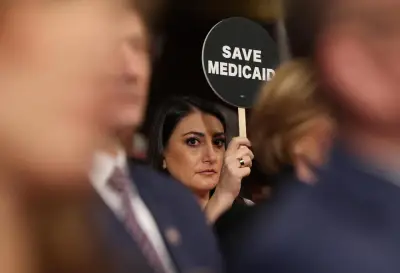Republicans in Congress are eyeing cuts to Medicaid. But what does Medicaid actually do?

By Shalina Chatlani Stateline org Republicans in Congress are eyeing billion in cuts to Medicaid the joint federal-state executive vitality care activity for lower-income people Depending on how states respond a Republican proposal that would slash the federal contribution to states expanded Medicaid programs would end coverage for as a large number of as million of the million people on Medicaid or cost states billion over the next decade to keep them on the rolls More than million people could lose coverage if the feds impose work requirements In up-to-date months this complicated cabinet project has increasingly come under the spotlight so Stateline has put together a guide explaining what Medicaid is and how it operates Medicaid is not Medicare Medicaid serves people with lower incomes or who have a disability Medicare focuses primarily on older people no matter their income Related Articles States push Medicaid work rules but scant programs help enrollees find jobs Battenfeld Trump declaring war on elitist Harvard pocketbook Supreme Court blocks for now deportations of Venezuelans held in northern Texas under an th century wartime law EEOC instructs staff to sideline all new transgender discrimination cases employees say Tropical drinks by the pool Not so fast says senator who visited Abrego Garcia in El Salvador Medicaid and Medicare were created in under President Lyndon B Johnson Medicare is the federal vitality insurance project for people who are or older though younger people with special circumstances such as permanent kidney failure or ALS may be eligible earlier Medicare is a supplemental insurance activity that s limited in scope It doesn t pay for long-term care majority dental care or routine physical exams Around million people are enrolled in Medicare Medicaid is a more comprehensive authorities insurance plan that s jointly funded by the federal administration and states Medicaid covers majority nursing home care as well as home- and community-based long-term care People on Medicaid generally don t have any copayments Only people and families with incomes under certain thresholds are eligible for Medicaid About million people or a fifth of people living in the United States receive Medicaid benefits Medicaid eligibility varies from state to state In its original form Medicaid was generally only available to children and parents or caretakers of eligible children with household incomes below of the federal poverty line for a family of four in Over the years the scheme was expanded to include particular pregnant women older adults blind people and people with disabilities States have to follow broad federal guidelines to receive federal funding But they have key flexibility in how they design and administer their programs and they have different eligibility rules and offer varying benefits In President Barack Obama signed into law the Affordable Care Act also known as Obamacare which allowed states to expand their eligibility thresholds to cover adults with incomes up to of the federal poverty line about for one person nowadays in exchange for greater federal matching funds The District of Columbia covers parents and caretakers who earn up to of the federal poverty line Only states Alabama Florida Georgia Kansas Mississippi South Carolina Tennessee Texas Wisconsin and Wyoming have chosen not to expand coverage In the non-expansion states eligibility for caretakers and parents ranges from of the federal poverty line in Texas to in Tennessee In Alabama people can only get Medicaid if they earn at or below of the federal poverty line a year for a three-person household Traditional Medicaid exists alongside a healthcare insurance campaign for children called CHIP Low-income children have perpetually been eligible for Medicaid But in Congress created CHIP or the Children s Physical condition Insurance Initiative The law gave states an opportunity to draw down enhanced federal matching funds to extend Medicaid coverage to children within families who earn too much money to qualify for traditional Medicaid coverage but make too little money to afford commercial wellness care Like Medicaid CHIP is jointly funded by the federal executive and states but it s not an entitlement operation CHIP is a block grant project meaning states receive a fixed amount of federal money every year and aren t obligated to cover everyone who meets the eligibility requirements States get to decide within broad federal guidelines how their CHIP programs will work and what the income limits will be Various states have chosen to keep their CHIP and Medicaid programs separate while others have decided to combine them by using CHIP funds to expand Medicaid eligibility Medicaid and CHIP are vital portions of state budgets In the federal executive spent less on Medicaid and CHIP than on Medicare with Medicare spending accounting for or billion of the federal benefit budget and Medicaid and CHIP accounting for or billion But at the same time Medicaid is the largest source of federal funds for states accounting for about a third of state budgets on average and of all federal funding the states received last year Federal funding varies by state Before the Affordable Care Act federal Medicaid funding to states mostly depended on a formula known as the FMAP or the federal therapeutic assistance percentage which is based on the average personal income of residents States with lower average incomes get more financial assistance For example the federal cabinet reimburses Mississippi which is relatively poor nearly for every it spends for a net state cost of But New York is only reimbursed By law the FMAP can t be less than The ACA offered states the opportunity to expand eligibility and receive an even greater federal matching rate In expansion states the federal governing body covers of costs for expansion adults If Republicans in Congress reduce that percentage states would have to use their own money to make up for lost federal dollars They might have to scale back Medicaid coverage for chosen groups eliminate optional benefits or reduce provider payment rates Alternatively they could raise taxes or make cuts in other large budget items such as training Another possibility is that states that have adopted Medicaid expansion would reverse it Nine states Arizona Arkansas Illinois Indiana Montana New Hampshire North Carolina Utah and Virginia already have trigger laws in place that would automatically rescind expansion if the federal match rate dips below Other states are considering similar ordinance One new analysis from KFF a vitality research program group located that if Congress reduced the federal match for the expansion population to the percentages states get for the traditional Medicaid population for the wealthiest states and for the poorest ones it would cost states billion over the next decade to keep everyone eligible under Medicaid expansion on the rolls Medicaid is the largest source of robustness coverage especially for people with low incomes Medicaid is the single largest wellbeing payer in the nation and is particularly essential for people in poverty Almost a fifth of people living in the United States are covered through Medicaid But nearly half of all adults with incomes at or below the federal poverty line are insured through the plan Medicaid covers out of every children overall but it covers out of every children below the federal poverty line Medicaid also provides coverage for people experiencing homelessness or who are leaving incarceration Medicaid covers essential services such as childbirth In exchange for receiving federal funds states are obligated to cover essential healthcare care services including inpatient and outpatient hospital services professional visits laboratory work and home robustness services among other things States get to decide which optional services such as prescription drugs and physical therapy they want to cover Medicaid is a vital payer of essential services For example the effort covers of all childbirths in the U S and covers wellbeing care services for the of all adults ages - with HIV The majority of Medicaid spending goes to people with disabilities and to pay for long-term care ACA expansion adults about out of every enrollees accounted for of total Medicaid expenditures in Children who make up about out of every enrollees only accounted for of spending People who qualify for Medicaid because of a disability or because they are over the age of make up about out of every enrollees But they accounted for more than half of all Medicaid spending That s because these populations typically experience higher rates of chronic illness and require more complex clinical care Older people are also more likely to use nursing homes and other long-term care facilities which can be expensive Cuts could also mean that older people relying on Medicaid for home-based care and long-term nursing home services could be significantly affected Certain state Medicaid programs cover people who are living in the country illegally People who are in the country illegally are ineligible for traditional Medicaid or CHIP But particular states have carved out exceptions to extend coverage to them using state dollars As of January states and the District of Columbia provide Medicaid coverage to children regardless of their immigration status And states plus the District of Columbia use CHIP to cover pregnant enrollees regardless of their immigration status Also seven states provide Medicaid to chosen adults who are here illegally New York opted to cover those who meet the income requirements and are over the age of regardless of immigration status And California provides coverage to any adults ages - who are under the income threshold regardless of immigration status The majority of the residents holds favorable views of Medicaid According to surveys from KFF two-thirds of Americans say that someone close to them has received physical condition coverage from Medicaid at chosen point in their lives Half of the residents also say they or someone in their family have been covered through Medicaid Generally around out of every people regardless of political party say that Medicaid is very major though Republicans are less likely than Democrats and independents to share that opinion At the same time a third or less of people want to see any decrease in spending on the Medicaid operation In fact the majority of people living in states that have not expanded Medicaid under the ACA want their states to do so Stateline reporter Shalina Chatlani can be reached at schatlani stateline org States Newsroom Visit at stateline org Distributed by Tribune Content Agency LLC


